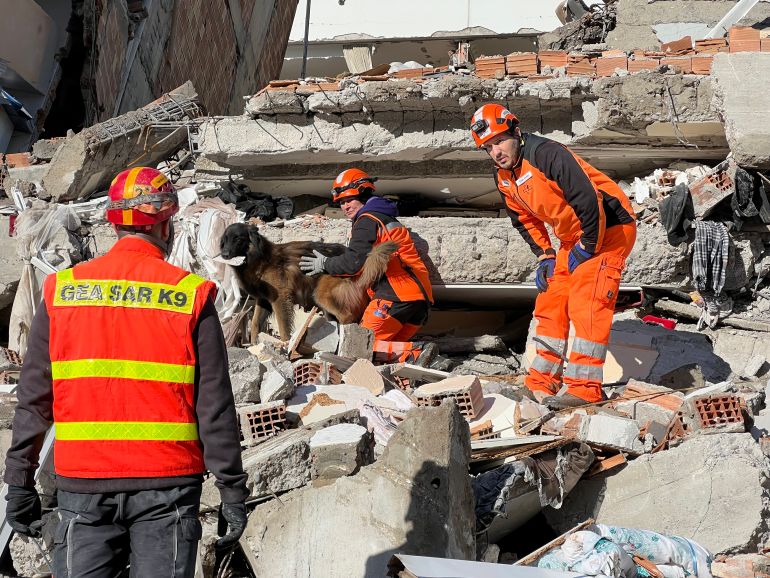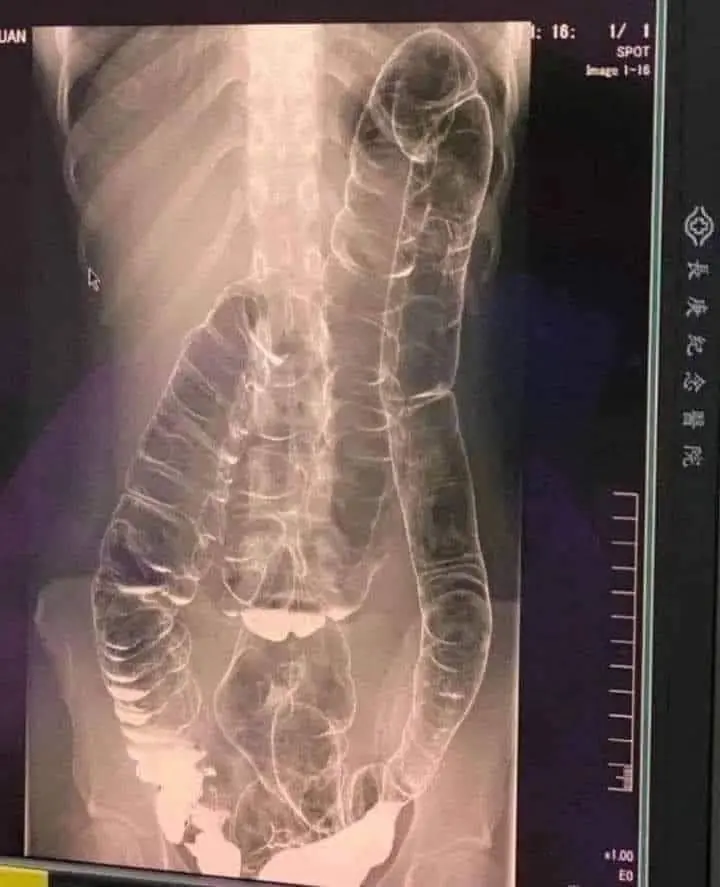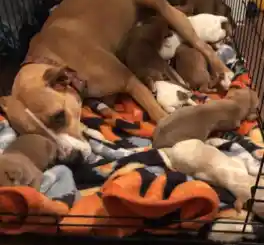Trained rescue dogs are helping to find survivors buried underneath layers of concrete and otherwise undetectable.

Hours after two huge earthquakes and hundreds of aftershocks struck southeastern Turkey and northwestern Syria on February 6, some much-needed rescuers began to arrive in Turkey – K9 teams from around the world that had come to lend a hand to GEA, a Turkish volunteer rescue team.
K9, a homophone of canine, is a dog specially trained to assist security forces and emergency teams – in rescues, drug enforcement or other operations. These dogs came from, among other countries, El Salvador, Germany, Mexico, Qatar, South Korea, Switzerland, Ukraine and the United States.
The much-welcomed rescuers, who can find victims by scent alone, are needed to help the Turkish K9 teams in desperate operations where buildings as high as 14 storeys have collapsed, making it difficult to find survivors by sight or sound.
REDOG, a K9 volunteer team from Switzerland, is on the ground in the Turkish city of Iskenderun, working with the local GEA team, an all-volunteer search and rescue group.
Since arriving on February 6 near midnight, the team of 10 people and six trained dogs together with GEA have so far found 39 people alive under the rubble.
The dogs are trained to sniff out a human scent, stand at the spot and bark loudly to alert their handlers to the spot where they have found it. A second dog is then released to see if it can confirm the findings.

If the two dogs confirm, this allows human rescuers to concentrate their digging efforts on that particular spot until they find the person.
“I think it’s one of the most emotional moments of my life … the moment when one of our dogs signals to us that he found some people in the rubble,” REDOG’s vice chief for rubble search Matthias Gerber told Al Jazeera.
The dogs work all day in teams of three at rubble sites, taking turns to work 20-minute shifts, followed by 40-minute breaks.
In one case after their dogs signalled the location of where people were buried, human rescuers began digging at the spot and soon heard knocking coming from behind the rubble from the victims trapped inside, confirming what the dogs had already pinpointed.
“Eight hours later of hard work, they saved four people alive from this position,” Gian Forster, REDOG team leader who works with three dogs, told Al Jazeera.
Every time a REDOG dog finds a person, he or she is praised and rewarded with a toy or food.
“He really likes to find people because he gets rewarded every time,” Forster said. “The main thing is that the dog has fun and likes to search for the people.”

If the survivor isn’t buried too deep, the dogs can pick up on the scent quite quickly. But some buildings in Iskenderun have six floors that have collapsed with 2-3 metres (4-6 feet) of concrete pancaked in between each level, making it a challenge to find people buried more deeply.
“If it takes time for the scent to come up, we have to go [to the spot of debris] and remove some [floors of] rubble and try again. It’s quite a hard process if the person is buried that deep,” Gerber said.
Describing a recent rescue, Gerber said: “We arrived at the rubble field and we started searching on top of the roof of the building, and we didn’t get any scent there. And then Gian thought about how the wind is coming from the west, so we searched the east side of the rubble and there, the dogs [detected] the scent from the person.”
The dogs working with REDOG on the ground in Turkey – among them labradors, German shepherds, Belgian shepherds, border collies and golden retrievers – have up to seven years’ experience working in rescue missions and have helped find survivors after disasters in Japan, Nepal and Albania.

But, Gerber said, in the last 30 years of his rescue dog work, the current mission in Turkey is the most challenging and tragic that he has experienced, referring to the scale of destruction.
“For our dogs, it’s very hard if there is so much rubble on top of the victims to find them. It’s a big obstacle for us. It’s good if we can come back to the same rubble site after they removed some floors of rubble and search again, because then we’ll have a chance to find people alive even if they’re buried very deep,” Gerber said.
Murat Kurum, the Turkish minister of environment, urbanisation and climate change, has said that more than 41,700 buildings in 10 affected provinces in the country’s southeast had either collapsed, urgently needed to be torn down or were severely damaged, according to state news agency Anadolu.
At least 1,791 buildings in 10 provinces that were affected have been identified as being severely damaged or requiring immediate demolition.
“It’s horrible what happened here. All these collapsed buildings, all these people who lost their relatives, their homes. It’s horrible,” Gerber said.
“We are happy to help here with our dogs, to get people out alive. It’s really important. It really moves me that we can help here.”
So far, of the 2,000 calls that GEA has received, REDOG, working with the GEA, has answered about 200 of them, he said.

California-based NGO National Disaster Search Dog Foundation (SDF) has trained seven of the 12 rescue dogs deployed from the US currently searching for survivors in Turkey.
Denise Sanders, director of communications and search team operations, told Al Jazeera that the dogs are “so much better at detecting scents than any technology that we have”.
“They run over the top of rubble and do what’s called air sensing. They’re picking up those scent particles in the air and then following their nose quite literally to the strongest scent source, and that would be the point of the potential victim,” Sanders said.
Knowing from past experience working in the aftermath of earthquakes such as in Haiti, she said dogs have shown that they are able to sniff “very distinct scents that are very dispersed in the air”, as deep as 6-9 metres (20-30 feet) below the surface.
“In Haiti in particular, we had collapsed buildings that had been six, seven storeys tall that pancake-collapsed … We know that the dogs were able to locate [the survivors] and alert,” Sanders said.

For a dog to be trained and skilled at finding survivors, they naturally need to have drive, determination and “boundless energy”, Sanders said.
“This is not your pet that you toss the toy for in the back yard a couple of times and they kind of get tired and lay down. These dogs will go until they drop, until you tell them it’s time to stop.
“That kind of resilience and determination is exactly what we need… they’re [on the ground] for one, two weeks and they need to cover a massive area, and check so many different sites and run over so many different mountains of rubble.
“They don’t necessarily make great pets [due to their high energy]; they are not able to settle quite as well as the average dog, so we really try to channel that into a job that they love.”
The K9 rescuers are dedicated to their work, and they face as many dangers as their human partners do. Proteo, a German shepherd working with the Mexican rescue team in Kahramanmaras, died this past week when the remains of a building he was searching in fell on him. He has been honoured as a hero by the Mexican defence ministry.
The members of the Mexican army and air force. We deeply regret the loss of our great companion, the dog: Proteo. You fulfilled your mission as a member of the Mexican delegation in the search and rescue of our brothers in Turkey. Thank you for your heroic work.
CHRONIC CONSTIPATION – A SILENT THREAT TO YOUR DIGESTIVE HEALTH
Constipation may seem like a minor inconvenience, but when left untreated for extended periods, it can lead to severe health consequences. Below is a real-life case that highlights just how dangerous chronic constipation can be and why you should never ignore it.
Shocking X-ray Image of a Patient with Long-Term Constipation

The X-ray image below belongs to a young woman who suffered from chronic constipation for years. One day, her condition worsened, and she went for over two weeks without a bowel movement. Concerned, she finally sought medical help, only to receive alarming results.
The Root Cause:
- When the digestive system is unable to expel waste properly, stool begins to accumulate in the colon, causing severe discomfort and pain.
- Over time, the colon stretches beyond its normal capacity to hold the excessive buildup of fecal matter.
- In the X-ray, you can see how the colon has expanded dramatically, reaching up towards the chest area, near the heart.
- The normal folds and wrinkles of the colon, which are essential for its function, have almost disappeared due to extreme bloating and distension.
This condition, often overlooked, can lead to life-threatening complications if not addressed in time.
The Dangerous Consequences of Chronic Constipation
Severe Colon Distension
- When the colon is forced to expand beyond its natural limit, it gradually loses its ability to contract and push stool forward.
- This results in worsening constipation, making it even harder for the body to have a natural bowel movement.
Video : Constipation: The Silent Danger Hiding in Your Gut and How to Avoid It
Toxin Build-Up in the Body
- When waste remains in the colon for too long, harmful toxins and bacteria can be reabsorbed into the bloodstream.
- This can cause chronic fatigue, acne breakouts, bad breath, bloating, and weakened immunity.
Hemorrhoids & Anal Fissures
- Excessive straining while attempting to pass hard stools can lead to hemorrhoids (swollen veins in the rectum), which cause pain and bleeding.
- Severe cases may result in anal fissures, tiny tears in the anus that make bowel movements extremely painful.
Intestinal Blockage (Bowel Obstruction)
- One of the most life-threatening complications of untreated constipation is bowel obstruction.
- When waste completely blocks the intestines, it can cut off blood supply to the gut, causing tissue death (necrosis) and serious infections.
- In extreme cases, patients may require emergency surgery to remove the damaged part of the intestine.
Increased Risk of Colon Cancer
- Studies have suggested that chronic constipation may be linked to a higher risk of colorectal cancer.
- The prolonged presence of waste in the colon increases exposure to carcinogenic (cancer-causing) substances, leading to inflammation and abnormal cell growth.
How to Prevent and Treat Constipation Naturally

The good news is that constipation is preventable with a few simple lifestyle adjustments. Here’s how you can keep your digestive system running smoothly:
Increase Fiber Intake
- Eat more fruits, vegetables, whole grains, nuts, and seeds.
- Foods like chia seeds, flaxseeds, apples, pears, and prunes are excellent natural laxatives.
Stay Hydrated
- Drink at least 2-3 liters (8-12 cups) of water per day to soften stools and promote bowel movements.
- Warm lemon water in the morning can help stimulate digestion and relieve constipation.
Exercise Regularly
- Movement helps stimulate the intestines and encourages regular bowel activity.
- Try walking, yoga, or stretching exercises for 15-30 minutes daily.
Develop a Consistent Bathroom Routine
- Train your body to go at a regular time each day, preferably after meals.
- Avoid holding in bowel movements, as this can make constipation worse over time.
Limit Processed & Low-Fiber Foods
- Cut back on fried foods, fast food, dairy, red meat, and refined carbohydrates (white bread, pastries, sugary snacks).
- These foods slow digestion and contribute to hard stools.
Try Natural Remedies
- Drinking warm herbal teas (such as ginger tea, peppermint tea, or fennel tea) can soothe digestion.
- Aloe vera juice and magnesium supplements are also helpful for easing constipation.
Video : Man’s Extreme Constipation Nearly Kills Him
 Important Reminder:
Important Reminder:
If you haven’t had a bowel movement in 2-3 days, start paying close attention to your diet and lifestyle. If constipation persists for over a week, or you experience severe pain, bloating, vomiting, or blood in your stool, seek medical attention immediately.
Final Thoughts
Constipation isn’t just an uncomfortable nuisance—it can turn into a serious health problem if left untreated. Taking proactive steps to support your digestive system can prevent long-term complications and keep your gut healthy.
Your health starts with small daily habits—so don’t ignore what your body is telling you!



Leave a Reply